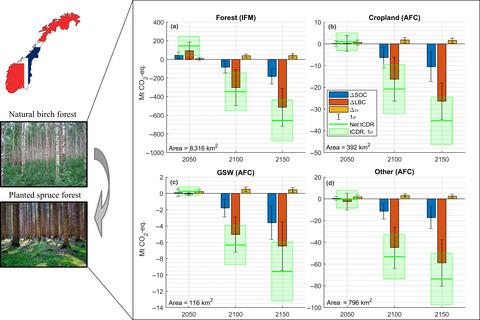当前位置:
X-MOL 学术
›
Glob. Change Biol.
›
论文详情
Our official English website, www.x-mol.net, welcomes your
feedback! (Note: you will need to create a separate account there.)
Evaluating the terrestrial carbon dioxide removal potential of improved forest management and accelerated forest conversion in Norway.
Global Change Biology ( IF 10.8 ) Pub Date : 2020-06-19 , DOI: 10.1111/gcb.15228 Ryan M Bright 1 , Micky Allen 1 , Clara Antón-Fernández 1 , Helmer Belbo 1 , Lise Dalsgaard 1 , Stephanie Eisner 1 , Aksel Granhus 1 , Olaug J Kjønaas 1 , Gunnhild Søgaard 1 , Rasmus Astrup 1
Global Change Biology ( IF 10.8 ) Pub Date : 2020-06-19 , DOI: 10.1111/gcb.15228 Ryan M Bright 1 , Micky Allen 1 , Clara Antón-Fernández 1 , Helmer Belbo 1 , Lise Dalsgaard 1 , Stephanie Eisner 1 , Aksel Granhus 1 , Olaug J Kjønaas 1 , Gunnhild Søgaard 1 , Rasmus Astrup 1
Affiliation

|
As a carbon dioxide removal measure, the Norwegian government is currently considering a policy of large‐scale planting of spruce (Picea abies (L) H. Karst) on lands in various states of natural transition to a forest dominated by deciduous broadleaved tree species. Given the aspiration to bring emissions on balance with removals in the latter half of the 21st century in effort to limit the global mean temperature rise to “well below” 2°C, the effectiveness of such a policy is unclear given relatively low spruce growth rates in the region. Further convoluting the picture is the magnitude and relevance of surface albedo changes linked to such projects, which typically counteract the benefits of an enhanced forest CO2 sink in high‐latitude regions. Here, we carry out a rigorous empirically based assessment of the terrestrial carbon dioxide removal (tCDR) potential of large‐scale spruce planting in Norway, taking into account transient developments in both terrestrial carbon sinks and surface albedo over the 21st century and beyond. We find that surface albedo changes would likely play a negligible role in counteracting tCDR, yet given low forest growth rates in the region, notable tCDR benefits from such projects would not be realized until the second half of the 21st century, with maximum benefits occurring even later around 2150. We estimate Norway's total accumulated tCDR potential at 2100 and 2150 (including surface albedo changes) to be 447 (±240) and 852 (±295) Mt CO2‐eq. at mean net present values of US$ 12 (±3) and US$ 13 (±2) per ton CDR, respectively. For perspective, the accumulated tCDR potential at 2100 represents around 8 years of Norway's total current annual production‐based (i.e., territorial) CO2‐eq. emissions.
中文翻译:

评估挪威改善森林管理和加速森林转化的陆地二氧化碳清除潜力。
作为一种二氧化碳清除措施,挪威政府目前正在考虑在自然过渡到以落叶阔叶树种为主的森林中的土地上大规模种植云杉(云杉(Pice abies(L)H. Karst))的政策。鉴于希望在21世纪下半叶实现排放与清除的平衡,以将全球平均温度限制在“远低于” 2°C的愿望,鉴于云杉增长率相对较低,这种政策的有效性尚不清楚在该区域。进一步令人困惑的是与此类项目相关的地表反照率变化的幅度和相关性,这通常抵消了森林CO 2增强的好处。下沉在高纬度地区。在此,我们根据经验对挪威大规模云杉种植的陆地二氧化碳清除(tCDR)潜力进行了严格的基于经验的评估,考虑了21世纪及以后的陆地碳汇和地表反照率的瞬时变化。我们发现地表反照率的变化在抵消tCDR方面可能起着微不足道的作用,但是鉴于该地区的森林生长速度低,这种项目的tCDR显着收益要到21世纪下半叶才能实现,即使是最大收益也是如此。之后大约在2150年。我们估计挪威在2100年和2150年(包括地表反照率变化)的累计tCDR潜力分别为447(±240)和852(±295)Mt CO 2-eq。每吨CDR的平均净现值分别为12美元(±3)和13美元(±2)。为便于观察,在2100年累积的tCDR潜力约占挪威当前基于年度总生产量(即领土)的CO 2当量的8年。排放。
更新日期:2020-08-11
中文翻译:

评估挪威改善森林管理和加速森林转化的陆地二氧化碳清除潜力。
作为一种二氧化碳清除措施,挪威政府目前正在考虑在自然过渡到以落叶阔叶树种为主的森林中的土地上大规模种植云杉(云杉(Pice abies(L)H. Karst))的政策。鉴于希望在21世纪下半叶实现排放与清除的平衡,以将全球平均温度限制在“远低于” 2°C的愿望,鉴于云杉增长率相对较低,这种政策的有效性尚不清楚在该区域。进一步令人困惑的是与此类项目相关的地表反照率变化的幅度和相关性,这通常抵消了森林CO 2增强的好处。下沉在高纬度地区。在此,我们根据经验对挪威大规模云杉种植的陆地二氧化碳清除(tCDR)潜力进行了严格的基于经验的评估,考虑了21世纪及以后的陆地碳汇和地表反照率的瞬时变化。我们发现地表反照率的变化在抵消tCDR方面可能起着微不足道的作用,但是鉴于该地区的森林生长速度低,这种项目的tCDR显着收益要到21世纪下半叶才能实现,即使是最大收益也是如此。之后大约在2150年。我们估计挪威在2100年和2150年(包括地表反照率变化)的累计tCDR潜力分别为447(±240)和852(±295)Mt CO 2-eq。每吨CDR的平均净现值分别为12美元(±3)和13美元(±2)。为便于观察,在2100年累积的tCDR潜力约占挪威当前基于年度总生产量(即领土)的CO 2当量的8年。排放。











































 京公网安备 11010802027423号
京公网安备 11010802027423号